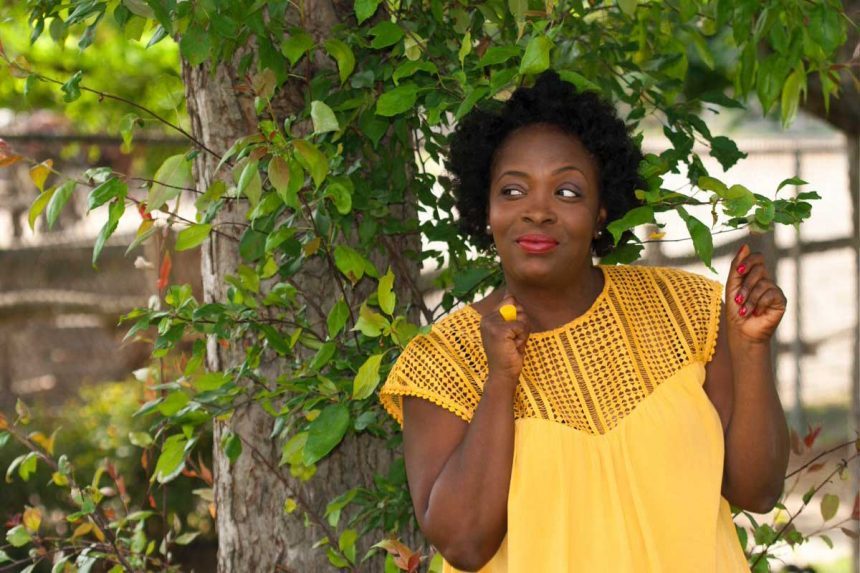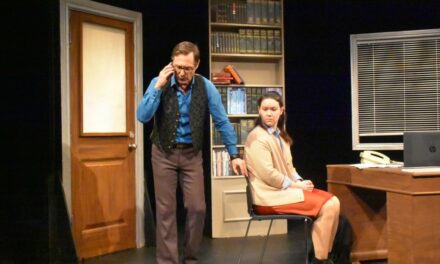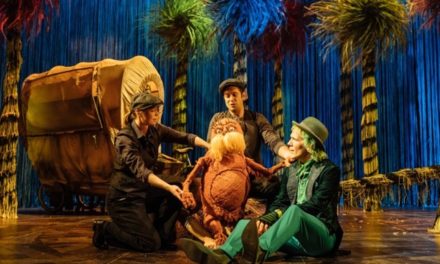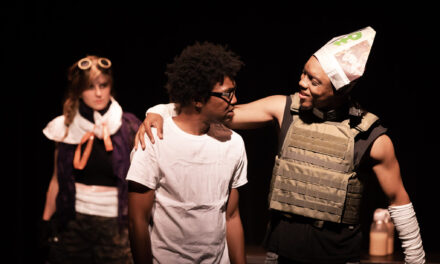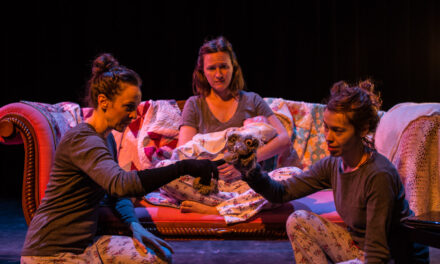Review: White Man’s Indian presents a new take on the coming-of-age narrative.
Darla Contois’ tour-de-force writing and performance are supported by some of the most polished design and staging that I have seen at SummerWorks this year. White Man’s Indian is about Eva, a Cree teenage girl who moves off the reserve to live with her absentee father after her mother dies. It is simplistic to call this a coming-of-age story because the issues that Eva deals with go beyond the kind of fare you would expect in a play about adolescence. That said, all of the issues about identity that Contois, through Eva, negotiates are mapped onto precisely those usual narrative suspects—navigating high school friendships, gossiping about boys, planning for graduation, and more.
Contois pirouettes through multiple roles, subtly and impressively changing her posture and voice to represent characters as diverse as Eva’s alcoholic father and the ditzy popular girl at school. Standouts are “the twins,” an uncool (and hugely funny) pair of Eva’s classmates at her new high school who scoop her up into their social circle shortly after she arrives. Even Eva, Contois’ performative home base, evolves through the duration of the play, moving from moments of childhood vulnerability to a determined clarity in the show’s final minutes. On a very spare set, Contois’ virtuosic performance is deeply praiseworthy.
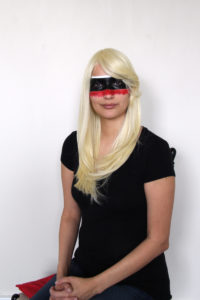
White Man’s Indian. Playwright: Darla Contois. SummerWorks Toronto 2017. Photo by Peatr Thomas.
Eva struggles to acclimate to her new urban environment because, although her life’s experiences have been significantly different than those of her peers at the white high school, she urgently wants a normal life. Of course, “normal” here is determined by the lives she sees her peers living. Her classmates and teachers are clueless (and likely don’t care to be clued in) about Eva’s heritage, and yet Eva feels disconnected from the identity that is, in the eyes of those around her, meant to shape her. In one scene, after being assigned a school project on her family’s history and traditions, she laments that she doesn’t know the story of her people. It has been erased by the brutal colonial policies and practices of Europeans and their descendants that deliberately sought to eradicate Indigenous cultures.
She calls herself the perfect ‘white man’s Indian’ because she can’t remember her past or speak her language. She even sometimes craves assimilation with the white world she inhabits because she is exhausted by others’ expectations about her identity. And yet, she can’t. Toward the end of the play, while she readies herself for an end-of-school party, she dons a blonde wig. She is so frustrated with being marked as ‘other’ because of her skin and hair-colour that she obscures her own looks to be, in her terms, ‘beautiful.’ These feelings are compounded by the often frightening instability in her home life, with a father who is too disengaged (and sometimes malicious) to help her at all. Eva feels like she doesn’t belong anywhere.
This play poignantly presents what it means to live a cultural identity that has been rubbed out within the society that perpetrated that erasure. Eva’s sense of loss is devastating because there is no way to restore that which was taken from her. Because her personal traumas are compounded by historical and cultural wrongs, she is lost.
White Man’s Indian has one more performance, tonight (Saturday, August 11) at 7pm at The Theatre Centre BMO Incubator.
Review: Spawn offers a return home
Cheyenne Scott’s very smart play intertwines Coast Salish stories and symbolism with the charming narrative of Theresa and Mikey who, after a casual encounter, are having a baby together. It is a story of transformations and returns. Theresa (Samantha Brown) is a young Indigenous woman who lives in Victoria and works as a dance teacher. Mikey (Dillan Meighan-Chiblow) lives on a reserve, which is where he first meets visiting Theresa. He offers to follow her back to Victoria after he learns that she is pregnant. Neither of them has particularly supportive families, so their efforts at establishing their own family unit are difficult. They know that they need each other, but Theresa is reluctant to become too reliant and Mikey doesn’t know the best way to support her.
Spawn is at its best in its quick and intelligent writing. The production is polished, with beautiful projections that play across a diaphanous sheet that the actors manipulate to create the illusion of water. The set is more robust than most at SummerWorks, featuring a central ramp that Theresa runs up (as though a salmon swimming up stream) and movable blocks that create the interior of Theresa’s apartment. The quick repartee between Theresa and Mikey is utterly delightful, and Cathy Elliot, as Theresa’s grandmother, is surprisingly complex given her limited stage time. That said, there are a few choices that seem a little too on-the-nose: Mikey occasionally appears in a salmon costume to wordlessly ‘swim’ around the stage, and the singular appearance of his tough-guy brother Travis feels redundant.

Spawn. Playwright: Cheyenne Scott. SummerWorks Toronto 2017. Photo by Blair Bouskill.
Even without the occasional salmon literally appearing on stage, it is clear that salmon and their journey act as a central metaphor, with several moments serving to underline the titular action: spawning, or creating something new by going back to where you came from. Theresa and her estranged father used to fish together; although he is at first unable to contend with the idea that his daughter is pregnant, they slowly stitch their relationship into form by returning to their tradition. Mikey presents Theresa with a reef net, a traditional method of fishing, as a way to bring himself into the fold with her father; all three have the means to move forward if they take up a very old practice. Theresa reconnects with her maternal grandmother who had disappeared from her life after her mother drowned; their connection is renewed through their shared memory of Saskatoon berry pie. In this way, as they all prepare to welcome the new baby, they find their way back home.
Spawn has two more performances: Saturday, August 12th at 9:30pm and Sunday, August 13th at 3:45pm, Factory Theatre Mainspace.
Review: The Chemical Valley Project and the art of storytelling
Storytelling is a venerated part of many Indigenous nations; their oral traditions are a tool for teaching histories and imparting important life lessons. In The Chemical Valley Project, written and performed by Kevin Matthew Wong, I am struck by the sensitivity and respect that Wong and co-creator Julia Howman show to their Indigenous subjects in adopting a storytelling voice. With an earnest mix of self-awareness, raw facts, and virtuosic projection and puppetry, Wong weaves his own story by touching on the past and positing better paths for the future.
The play is a kind of documentary: Wong shares with the audience how he came to care about Aamjiwnaang, an Indigenous community near Sarnia, Ontario. He anchors his larger message about the urgency and importance of Indigenous-led land and water protector movements in the stories of sisters Vanessa and Lindsay Gray. The Grays have been agitating, advocating, and educating people about the so-called Chemical Valley, an area near their home outside Sarnia where 40% of Canada’s chemical industry operates. The sisters served as dramaturgs for the play as well, lending their own experiences in activism to help shape how they and their work are represented.
The facts presented in the play are shocking. I learned that Sarnia’s air is the most polluted in Canada. I learned that nearly 40% of women from the reserve report having experienced a miscarriage, and that the birth rate in Aamjinwnaang skews female; for every two girls born there is only one boy, where the expected rate is almost exactly one-to-one. Residents report breathing difficulties, skin irritations, and other symptoms that can be traced to their exposure to chemicals in their air and water. And then there is Enbridge’s troubling Line 9, a forty-year-old pipeline that carries diluted bitumen between Sarnia and Montreal and passes not far above the heads of commuters on the platform of Toronto’s Finch subway station.
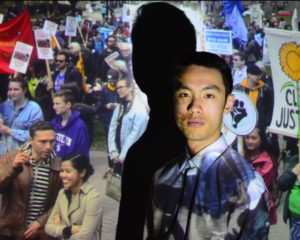
The Chemical Valley Project. Playwright: Kevin Matthew Wong. SummerWorks Toronto 2017. Photo by Julia Howman.
Wong’s careful way of placing himself in the narrative that he is weaving is smart. He manages to sidestep the chance that his work might seem sanctimonious by reflecting on his own skepticism as he once regarded protesters, and by considering how his own family from Hong Kong are colonizers in Canada. He shares his anxiety about telling a story that he cannot claim as his own. He talks about his own attempts to educate himself, and how he finally came to understand the centrality of land in first nations communities when he learned that the Ojibwa word for Earth (aki) is literally embedded in the word for everything (akina gegoo).
Significantly, Wong isn’t only a good storyteller; he has a charming sense of theatricality and is a skillful stage performer as well. The stage is set with two projectors, the larger of which provides a contextual backdrop for many scenes. The smaller projector is focused on a sheet draped over a table placed centre-stage. Wong manipulates the sheet by lifting, folding, and flourishing it like you might when hanging laundry out to dry. As the projections on the sheet change, the sheet becomes a puppet for two other characters, the backdrop for a bus trip, the Canadian flag, and more. This inventive staging is delightful, in spite of the play’s very serious subject matter.
I left The Chemical Valley Project with a sense of the value in stories and with a model for what it takes to really listen and come to understand others’ lived experience. I really do admire Kevin’s stage-craft, but more than that I respect his approach to the material. His performance is compelling because it is earnest, accessible, and very well told.
The Chemical Valley Project has one more performance, on Sunday, August 13th at 6:30pm at the Pia Bouman Studio Theatre.
Review: Professionally Ethnic perpetually relevant
In a program note, Bobby Del Rio explains that Professionally Ethnic is a decade old and that he is dismayed that its themes are still relevant. I’m not entirely sure that its issues can entirely be resolved.
Del Rio plays William, a theatre actor who dreams of lead roles because he is constantly cast as an “ethnic” supporting character. When Gerrard (David Sparrow), the director of an unnamed major theatre company, taps William to be at the center of a campaign to revitalize and diversify his organization, William is overjoyed. Tracy, played with whip-smart alacrity by Chantel McDonald, quickly points out to William that his ethnic identity is being monetized by Gerrard. She urges William to turn down the position. As Gerrard’s ambitions for William grow, he proposes that William can serve as a symbol of diversity itself. The play runs with this idea to its most extreme and absurd end, with William wearing a smorgasbord of “ethnic” costumes, none necessarily representing who William actually is, performing for an assembly of theatre board members.

Professionally Ethnic. Playwright: Bobby Del Rio. SummerWorks Toronto 2017. Photo by Ian Brown.
This brings the central concern of the play to the fore. In a funding climate that celebrates companies with a diversity mandate, multiculturalism becomes a box to tick for money. Although most companies will have the best intentions, are they not then using actors’ ethnicities to increase their cut of granting agencies’ pies? Conversely, should a non-white actor say no to potentially lucrative and interesting roles because they are tokenized and included in a production for the funding their inclusion portends? Tracy presents a possible solution by insisting that cultural institutions need to include more diversity in their leadership and not only on the stage. In the real world, the potential for money does beget change, but the play asks whether this is the right kind?
William ultimately wonders why he can’t just be himself; why does he have to represent anything other than his own unique experience? To drive his point home, the characters end the play in an argument about hockey, their passion for the Habs and Leafs being the only cultural marker that identifies them all.
Each performance of the play concludes with a long-table discussion of the issues presented, and I imagine that every one of these conversations has been very rich. This strikes me as a particularly important play for Toronto, where the city’s diverse languages and performance cultures are so often either isolated or tokenized. There aren’t easy answers, but Professionally Ethnic asks really key questions.
Professionally Ethnic has one more performance, on Sunday, August 13th from 6:00pm – 7:15pm at the Theatre Centre BMO Incubator. The listed run time includes a 30 minute Long Table Discussion that will take place after every performance.
Review: What Do You See? demands recognition
When Jasmyn Fyffe asks the audience “what do you see?” she puts her whole self on the line to discover our earnest answers. This piece is the result of Fyffe’s own exploration into what and how black female bodies signify. She draws on a rich catalog of historical and contemporary tropes about blackness to weave a performance that is both devastatingly uncomfortable and immensely beautiful to watch.
The piece begins with a literal representation of the titular question. Fyffe presses herself, face first and naked from the waist up, into a wall. As spectators enter the performance space, we are invited to take labeled stickers and affix them to her body. The labeled stickers range from descriptive (ie. the names of body parts, shades of brown), to evaluative (ie. dollar amounts, words of attraction or repulsion), to declarative (ie. instructions, including some very racist ones). About half of the spectators at the performance I attended actually labeled Fyffe. When the show begins, Fyffe pulls up the fabric that has been covering her lower half, uses it to cover her breasts, and moves into the middle of the stage.
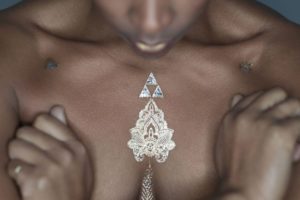
what do you see? Playwright: Jasmyn Fyffe. SummerWorks Toronto 2017. Photo by Michael Priebe.
The first movement in this three-act dance piece collapses centuries of racial stereotype into a frenetic pastiche of tropes. Fyffe first adopts the persona of a game-show host and, with a mile-wide smile and bright and brassy music playing, invites two spectators to stuff some batting into the rear end of her shorts. This creates the silhouette of Sarah Baartman, a Khoi woman who was put on display in the United Kingdom and in France in the early 19th century because of her large buttocks. Baartman was at the heart of heated debates on the abolition of slavery and she also served as a model for “scientists” who wanted to “prove” the difference between white and black bodies. After her death, her body was dissected and displayed in Parisian museums until the mid-1970s. In adopting Baartman’s silhouette, Fyffe positions her own body in the historical context of black female bodies-as-objects of the white Western gaze, and simultaneously aligns herself with other late 20th– and 21st-century thinkers and artists who have been exploring Baartman’s exploitation as an example of racism (including Jacqui du Toit’s The Hottentot Venus – Untold, reviewed in Alt.theatre by Brie McFarlane). Fyffe-as-Baartman explodes through different social dances; I spotted things as varied as the cakewalk, Charleston, and even twerking. Although social dances have historically been about creating community, they have also been parodied and commodified, making Fyffe’s performance all the more complex.
Fyffe turns into the second movement of her piece with a grin that slowly distorts her face to the point of pain. She removes the batting and enters into a wrestling match with the oversized white shirt that had previously been tied around her waist and used to cover her breasts. The symbolism of a black body being held down and distorted by white fabric was not subtle, and Fyffe’s performance was so virtuosic that it was heartbreaking to watch. Her struggle against this overwhelming and controlling force is made more urgent by the emergence of her own brown skin. It looked a bit like drowning.
The sound score then shifts to the sound of water and in this third act Fyffe begins a kind of cleaning. She tears off the stickers that had been placed on her and transforms the white shirt into a head wrap. In this final section, her dance becomes liberated; instead of struggling contortion, her movement is lyric and rhythmical. The transformation between the first moments of the piece and this closing act bring Fyffe’s initial question back to mind: what do we see? Although I’m reluctant to speculate what she wanted us to see, I see that Fyffe’s naked body is no longer objectified, classified, or the object of scrutiny. She is in her own skin, and there for / therefore herself.
what do you see? is part of a double bill with Mother Sea / Manman la Mer. The last chance to see both shows will be Sunday August 13th from 12-1:15 at The Theatre Centre BMO Incubator.
Review: Mother Sea / Manman la Mer promises safe passage
Djennie Laguerre weaves Franco-Caribbean storytelling traditions with theatrical staging to tell a tale of mothers and daughters and what we pass down from generation to generation. The set is sparse with only one chair placed centre-stage; this choice facilitates Laguerre’s many jumps between locations and characters in her narrative and also draws focus to her words.
Mother Sea/Manman la Mer traces Laguerre’s journey as a child and a young woman in Canada through to a kind of re-birth with her grandmother, the eponymous Maman la Mer, in Haiti. There are two conflicting forces in the text that, to me, express some of the frustration and struggle that can characterize life after immigration. On the one hand, Laguerre was shaped by her mother’s wish to Canadian-ize, and on the other, Laguerre felt a spiritual lineage that drew her closer to her family and traditions back in Haiti. Ultimately, in the cathartic reunion with her Haitian family, Laguerre feels whole.
I had the sense, even though this was listed as a “workshop” performance, that Laguerre has spent considerable time crafting her words. Her storytelling is precise, marking her as a well-practiced teller. Although most of the story is told in English, she moves in and out of French and Haitian Kreyol to reveal the geographic diversity of her roots. She also takes on the roles of several other characters, including herself as a child, her mother, her grandmother, and her three ‘aunties’ from Cuba, Trinidad, and Canada (with all of their attendant accents). Together, Laguerre’s many voices stitch a kind of vocal rhythm that makes it feel like she is dancing between them.
In fact, it is the play’s rhythm that makes the performance stand out. Beyond Laguerre’s own carefully crafted language, she coaches the audience through one aspect of traditional Caribbean storytelling. Near the top of the play, we learn a call-and-response technique: when Laguerre says “Cric?” (Are you ready?) we say “Crac!” (Yes! We are ready!). Variants of this pattern are peppered through the piece, like é-cric / é-crac and misticri / misticrac. Admittedly, the spectators were sometimes so engulfed in Laguerre’s story that some of us forgot to participate, but these instances nonetheless flagged most of the pivotal moments in the piece. If we can imagine that the story had a score, the moments of call-and-response changed the time signature.
Further, musician Loucas Café framed Laguerre’s storytelling with rhythmical punctuation on his beaded maraca. He rarely enters into the playing space of the stage; instead, he walks its periphery and intently watches Laguerre’s performance. His interventions seem most conspicuous in moments when Laguerre is agitated, though he pulsed his maraca behind her narration as well. There are carefully chosen excerpts from recorded music too. These drift in and out to help establish time and location but also serve to distinguish between the rhythms of life in Canada and life in Haiti.
In a sense, all these rhythms used as storytelling devices underscore the fact that Laguerre’s story is, itself, about rhythms. She explores generational rhythms, where daughter becomes mother, and how perspectives shift in these adjustments. She also explores a kind of rhythm of self; she describes a moment of personal crisis in terms of “stopping” completely, and she is then restored to movement by Haitian music and dancing. In some ways, Laguerre’s journey is one of discovering her own pulse.
Mother Sea / Manman la Mer is part of a double bill with what do you see? The last chance to see both shows will be Sunday, August 13th from 12-1:15 at The Theatre Centre BMO Incubator.
This article originally appeared on Alt. Theatre on August 12th 2017 and has been reposted with permission.
This post was written by the author in their personal capacity.The opinions expressed in this article are the author’s own and do not reflect the view of The Theatre Times, their staff or collaborators.
This post was written by Cassandra Silver.
The views expressed here belong to the author and do not necessarily reflect our views and opinions.

